RESEARCH
Maternal mortality estimation at the subnational level: a model-based method with an application to Bangladesh
Estimation de la mortalité maternelle au niveau sous-national: une méthode à base de modèles appliquée au Bangladesh
Estimaciones de la mortalidad materna a nivel regional: método basado en modelos con aplicación en Bangladesh
Saifuddin AhmedI,*; Kenneth HillII
IJohns Hopkins University Bloomberg School of Public Health, 615 North Wolfe Street (E4642), Baltimore, MD, 21205, United States of America (USA)
IIHarvard Center for Population and Development Studies, Boston, USA
ABSTRACT
OBJECTIVE: To provide a model-based method of estimating maternal mortality at the subnational level and illustrate its use in estimating maternal mortality rates (MMrates) and maternal mortality ratios (MMRs) in all 64 districts of Bangladesh.
METHODS: Knowing that mortality is more pronounced among the poorer segments of a population, in rural areas and in areas with poor availability and utilization of maternal care, we used an empirical Bayesian prediction method to estimate maternal mortality at the subnational level from the spatial distribution of such factors.
FINDINGS: MMRs varied significantly by district in Bangladesh, from 158 maternal deaths per 100 000 live births at Dhaka district to 782 in the northern coastal regions. Maternal mortality was consistently higher in the eastern and northern regions, which are known to be culturally conservative and to have poor transportation systems.
CONCLUSION: Bangladesh has made noteworthy strides in reducing maternal mortality since 1990, even though the utilization of skilled birth attendants has increased very little. However, several areas still show alarmingly high maternal mortality figures and need to be prioritized and targeted by health administrators and policy-makers.
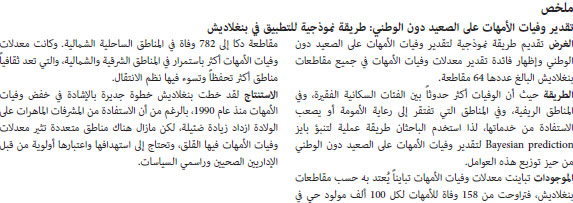

RÉSUMÉ
OBJECTIF: Fournir une méthode à base de modèles dans le cadre de l'estimation de la mortalité maternelle au niveau sous-national et illustrer son utilisation dans l'estimation des taux de mortalité maternelle (tauxMM) et des rapports de mortalité maternelle (RMM) dans les 64 districts du Bangladesh.
MÉTHODES: Sachant que la mortalité est plus prononcée dans les segments plus pauvres d'une population, dans les régions rurales et les régions disposant de peu de soins aux mères et y ayant peu recours, nous avons utilisé une méthode de prédiction bayésienne empirique afin d'estimer la mortalité maternelle au niveau sous-national à partir de la distribution spatiale de ces facteurs.
RÉSULTATS: Les RMM variaient considérablement par district au Bangladesh, de 158 décès maternels pour 100 000 naissances vivantes dans le district de Dhaka à 782 décès maternels dans les régions côtières du Nord. La mortalité maternelle était invariablement supérieure dans les régions de l'Est et du Nord, qui sont connues pour leurs systèmes de transport médiocres et pour être conservatives du point de vue culturel.
CONCLUSION: Le Bangladesh a fait des progrès remarquables en termes de réduction de la mortalité maternelle depuis 1990, même si le recours à des sages-femmes compétentes n'a enregistré qu'une légère augmentation. Cependant, plusieurs régions montrent aujourd'hui encore des chiffres de mortalité maternelle alarmants, que les responsables politiques et les gestionnaires de la santé doivent cibler et traiter en priorité.
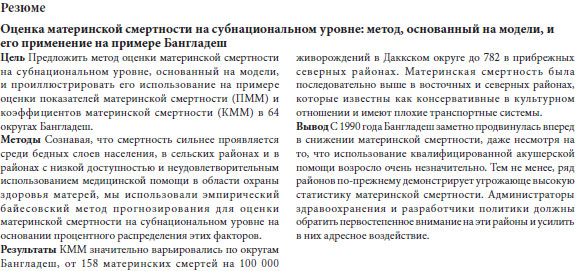
RESUMEN
OBJETIVO: Proporcionar un método basado en modelos para calcular la mortalidad materna a nivel regional y explicar su utilización en la estimación de las tasas de mortalidad materna (TMM) y las razones de mortalidad materna (RMM) en los 64 distritos de Bangladesh.
MÉTODOS: Para calcular la mortalidad materna a nivel regional y teniendo en cuenta que hay una mayor mortalidad en los sectores más desfavorecidos de la población, en las zonas rurales y en las áreas con una disponibilidad y utilización escasas de la asistencia materna, se utilizó un análisis bayesiano de predicción empírica a partir de la distribución espacial de dichos factores.
RESULTADOS: La RMM osciló de manera significativa en función del distrito de Bangladesh correspondiente: desde las 158 muertes maternas por 100 000 recién nacidos vivos en el distrito de Dhaka hasta las 782 de las regiones costeras del Norte. La mortalidad materna fue sistemáticamente superior en las regiones oriental y septentrional, conocidas por su cultura conservadora y por disponer de redes de transporte deficientes.
CONCLUSIÓN: Desde 1990 Bangladesh ha logrado avances notables en la reducción de la mortalidad materna, a pesar del escaso aumento de la asistencia por parte de matronas cualificadas. Sin embargo, algunas zonas siguen presentando unas cifras de mortalidad materna alarmantes y deben obtener prioridad y convertirse en el objetivo principal de los responsables sanitarios y políticos.
Introduction
The target of Millennium Development Goal 5 (MDG 5) is to reduce the maternal mortality ratio (MMR), defined as the number of maternal deaths per 100 000 live births, by three-quarters between 1990 and 2015. However, there are challenges involved in monitoring progress towards MDG 5 and in evaluating the impact of safe motherhood initiatives because accurately estimating maternal mortality is very difficult.1 This is especially so in developing countries, where vital registration systems are usually incomplete.
In the absence of complete vital registration systems with accurate attribution of causes of death, the methods used most commonly to estimate maternal mortality are household surveys with direct death inquiry, indirect and direct sisterhood methods and reproductive age mortality surveys. However, none of these methods is suitable for measuring maternal mortality in small geographical areas, where safe motherhood programmes are often implemented. As a result, health administrators and programme managers working on local safe motherhood programmes are often unable to monitor progress towards reducing maternal mortality in their areas or to set a specific numeric objective. Good subnational estimates are also essential for setting priorities, allocating resources and targeting areas where maternal mortality is high.
For countries lacking maternal mortality data, regression-based methods are used to make estimates. Of the 198 countries and territories included in a study conducted in 1990 by the World Health Organization (WHO) and the United Nations Children's Fund (UNICEF) to estimate maternal mortality, 114 countries (57.6%) had no nationally-representative data available and a regression model had to be used to estimate their maternal mortality figures.2 Subsequent attempts to estimate maternal mortality globally have shown only modest improvements in data availability.3, 4
Several factors explain the lack of national-level maternal mortality data. In statistical terms, maternal deaths are rare events and very large survey samples are needed to make estimates with reasonable confidence margins. As a case in point, the 2001 Bangladesh Maternal Health Services and Maternal Mortality Survey (BMMS), which was national in scope, comprised a sample of 104 323 households at a cost of about $US 1 million.5 Yet despite the large sample size, the MMR estimates for the three years preceding the survey (382 per 100 000 live births) had 95% confidence intervals (CIs) of ± 15%. Similarly, accurate estimates of maternal mortality at the subnational level are not feasible with the estimation methods currently available.
Several experts have recommended using process indicators, such as the percentage of births attended by skilled providers, as proxies for maternal mortality.6, 7 However, process indicators are not suitable proxies because their frequency in relation to maternal mortality varies across different settings. Overall in Asian countries, for example, 34% of deliveries are attended by skilled birth attendants and the estimated MMR is 540 maternal deaths per 100 000 live births. In contrast, in sub-Saharan Africa about 35% of the deliveries are attended by skilled birth attendants, yet the MMR is almost twice as high as in Asia (920 per 100 000 live births).
In the late 1980s, Graham et al. proposed the indirect sisterhood method primarily to overcome the need for a large sample in household surveys, and several developing countries adopted it.8 Rutenberg & Sullivan9 later proposed a direct method entailing more detailed questions on the survival status of all siblings, not just sisters. In both methods, female respondents who report having dead sisters are asked about the timing of the deaths in relation to pregnancy, and the response is recorded. Piggybacking on existing surveys in this fashion makes for less costly maternal mortality estimates. However, sisterhood methods are not suitable for making subnational estimates because the location of the deaths is not recorded.
Some studies using reproductive age mortality surveys or case-finding approaches have been conducted to estimate subnational MMRs.1, 10, 11 However, such approaches are very costly and seldom feasible. In this paper we propose a model-based approach that draws on the known distribution of certain population characteristics and contextual factors in a given area to estimate its MMR. This work is influenced by the literature of small area estimation methods based on generalized linear mixed models.12 We illustrate the method by applying it to Bangladesh using data from the 2001 BMMS.13
Methods
Data
The 2001 BMMS was a nationally representative survey of 103 796 ever-married women of reproductive age (15-49 years). The household questionnaire collected data broken down by age and sex on the deaths that occurred over the three-year period immediately before the survey. If deaths in women of reproductive age were reported, their timing relative to pregnancy was determined through additional questions. We first estimated the maternal mortality rate (MMRate, defined as the number of maternal deaths per 100 000 women of reproductive age) for all 64 districts in Bangladesh independently, and then estimated the maternal mortality ratio (MMR) for each district j by dividing each district's MMRate by its general fertility rate (GFR, defined as the number of live births in a year per 1000 women of reproductive age):
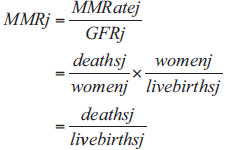
Our maternal mortality estimates are really pregnancy-related mortality ratios (PRMRs), as defined in WHO's International statistical classification of diseases and related health problems, 10th revision, since they include all deaths among women during pregnancy or within the 42 days following delivery, regardless of cause. In a standard household survey, true maternal deaths, which exclude deaths from incidental or accidental causes, cannot be distinguished from those that are pregnancy-related without additional information collected through verbal autopsy from close relatives of the deceased (e.g. mother, husband) about the signs and symptoms surrounding the death. All estimates of maternal mortality derived from sisterhood surveys are actually PRMRs, and historically-reported data are based primarily on PRMRs. To facilitate comparisons between our findings and those derived from other studies or available data sources, we included all pregnancy-related deaths as reported in the original BMMS and expressed maternal mortality in terms of MMRs. The true MMR based on BMMS and verbal autopsy is about 16% lower than the PRMR (e.g. 322 versus 382 maternal deaths per 100 000 live births).5
Statistical method
The maternal mortality rate can be estimated directly from a sample survey as

where di is the number of deaths and Nj is the number of women in area j. However, this direct method is not good for estimating maternal mortality at the subnational level. This is because in sample surveys, not all areas are represented in the sample, and samples from small geographical areas may not be large enough to provide a stable estimate.
Alternatively, maternal mortality can be estimated indirectly from the predicted values of the model as

where ε is an error term and  is a vector of auxiliary variables that are mortality predictors measured as an average of the values at the subnational level. An advantage of the indirect regression method is that the estimation is based on all the data available in the sample, rather than just on data for area j. There are, however, two specific problems with the indirect method: the prediction with equation:
is a vector of auxiliary variables that are mortality predictors measured as an average of the values at the subnational level. An advantage of the indirect regression method is that the estimation is based on all the data available in the sample, rather than just on data for area j. There are, however, two specific problems with the indirect method: the prediction with equation:

which ignores the error term ε and thus the heterogeneity across areas, and it rests on the assumption that areas having similar characteristics have identical maternal mortality. In summary, the direct method provides unbiased estimates, but they have low precision (poor efficiency due to small sample size and large variance). Worse still, it cannot yield any estimate at all if the area is not included in the survey or no death is observed in it because of its small size. On the other hand, indirect (or synthetic) estimates with a regression method are more efficient and precise, but they are not free from bias.
Random-effects models,14 also referred to as mixed models, are optimally based on both direct and indirect estimates and provide a balanced estimate. The prediction from the model, known as the best linear unbiased prediction (BLUP), is a weighted estimate of direct and indirect estimators and "borrows strength" (information) from related areas that also increase the effective sample size and thus increase precision.
In the random-effects (mixed) model,

where uj captures the heterogeneity across areas, uj~N(0, σ2u) and ε ij~N(0, σ2 ε).
The BLUP from the model is:

A problem with the BLUP is that the estimators are dependent on the variance components, which are typically unknown in practice. The variances are commonly replaced with asymptotically consistent estimators from the fitted models, and the BLUP is referred to as an empirical best linear unbiased prediction (EBLUP). We used an empirical Bayesian method to predict MMRates.
We drew on our knowledge that maternal mortality is associated with certain individual and community characteristics to fit a random-effects Poisson regression model, under a generalized mixed model specification, in which maternal death counts were modelled to their proximate determinants.15 All relevant variables available in the BMMS data, based on McCarthy & Maine's conceptual framework15 for maternal mortality determinants, were included in the model. Regressor (X) variables were: urban/rural residence of women (RES), administrative division (DIV), socioeconomic status (SES), skilled birth attendants at delivery (SBDA) and distance of nearest health facilities (DIS). All covariates were measured at the aggregate level. The fitted random-effects Poisson model was:

where β s are the model estimated coefficients, and log(py) is the offset term - logarithm of exposure measured in women person-years (py) of exposure (for the year of death, a woman contributed 0.5 person-years, otherwise py = 1 for each year of observation [survival] during the study reference period), and ν j is the residual error for area j. We used an empirical Bayesian method16 to predict the MMRate for each district j from the above model. The CIs for the predicted rates were based on the jackknife method.17
The estimation of the CIs for prediction is a challenging problem in the literature of mixed effects models because no closed formula for prediction error is available. Several approximate methods have been proposed for Gaussian linear mixed models, which are not suitable for count data fitted with random-effects Poisson regression models. Resampling procedures, bootstrapping and jackknife methods have been proposed to estimate the mean square error of BLUP for non-normal and nonlinear mixed models. We used a jackknife method to construct CIs for the EBLUP. The jackknife method is robust to misspecification and is commonly used in survey statistics to adjust variance estimation from complex survey data when the design effect > 1 owing to high intracluster correlation. All analyses were performed with Stata, version 10 (StataCorp LP, College Station, United States of America).
Results
Table 1 shows the observed MMRates and MMRs, with 95% CIs for all 64 districts in Bangladesh. The sample size at the district level, expressed in women person-years, ranged from 477 to 18 361. Such small samples are grossly inadequate for estimating maternal mortality. Furthermore, no maternal death was observed in 12 districts (19% of all districts). Thus, the estimated 95% CIs were either very wide or could not be estimated reliably. Such estimates are uninformative and useless for any practical purpose.
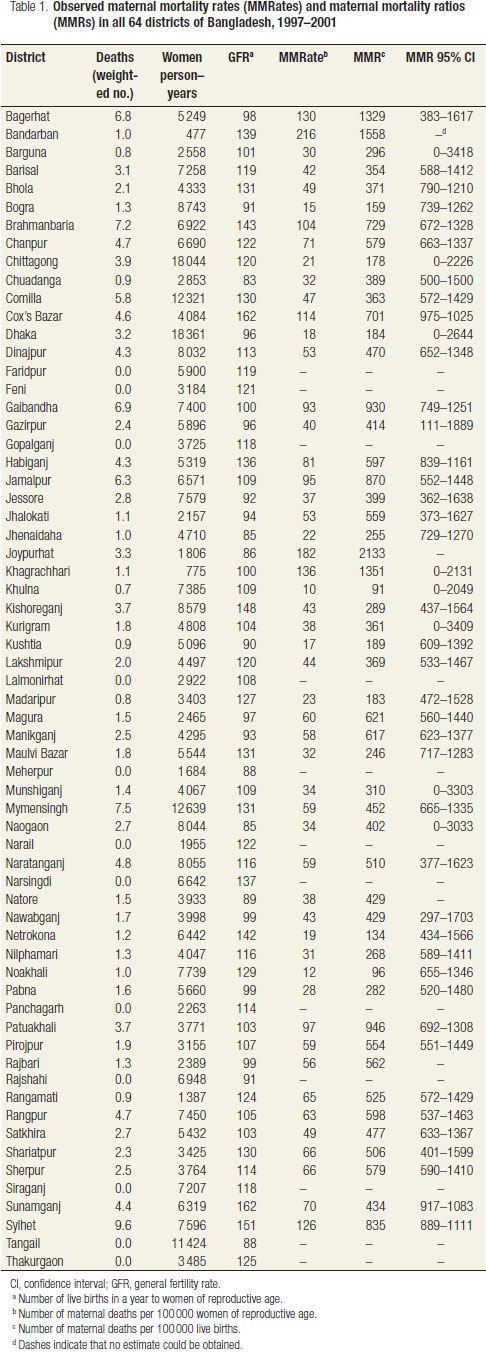
The model-based MMRates and MMRs are shown in Table 2. The estimated MMR ranged from 158 to 782 maternal deaths per 100 000 live births. In contrast, the observed MMR varied widely, from 91 to 2133 maternal deaths per 100 000 live births. The model-based 95% CIs were much narrower than the CIs of the observed estimates.
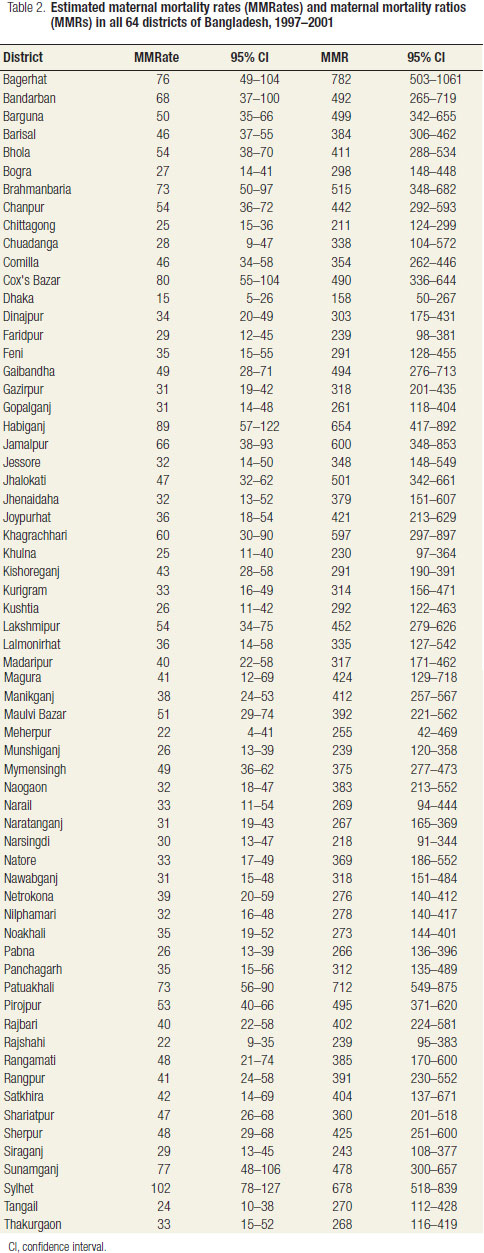
The MMR was lowest in the district of Dhaka, the capital of Bangladesh (158 100 000 per live births), and highest in the coastal districts, Bagerhat (782) and Patuakhali (712). High MMRs were found in most districts in Sylhet division, especially Sylhet and Habiganj (678 and 654, respectively). These two districts also had the highest MMRates (102 and 89 maternal deaths per 100 000 women of reproductive age, respectively).
The spatial distribution of MMRs across Bangladesh is shown in Fig. 1. Maternal deaths were more highly concentrated in the districts of Sylhet division and in the hill tract areas of Chittagong division (a predominantly mountainous territory located in south-east Bangladesh and inhabited by a tribal population), as well as in coastal areas (southern region). In central coastal districts communication is primarily by boat and cyclones and floods are frequent.
Fig. 2 shows the districts ranked by MMR and the national MMR from the 2001 BMMS; details on BMMS maternal mortality estimates have been published by Hill et al.5 In 28 (44%) districts, the MMR was higher than the national average.
A comparison of MMRates and MMRs across districts reveals some striking features. The MMR indicates the risk of death per pregnancy, whereas the MMRate indicates the overall (cumulative) risk of death per woman. In areas with a high GFR, MMR estimates can be comparatively low and therefore misleading. As an example, Bagerhat and Sunamganj have almost the same MMRate (76 and 77 per 100 000 women) but different GFRs (98 and 164 per 1000 women, respectively [not shown]). Women in Sunamganj misleadingly appear to have a substantially lower risk of maternal death than women in Bagerhat if we only look at MMRs (478 versus 782 per 100 000 live births, respectively).
A comparison of our findings with those from an earlier study in Bangladesh by Rahman et al.,10 in which a case-finding approach was used to identify deaths through hospital and community auditing, shows broad similarities in the spatial distribution of maternal deaths.
Conclusion
A maternal death is a rare event in the statistical sense and reliable estimates of maternal mortality call for population-based surveys with very large samples. It is not practical to estimate MMRs for small areas through sample surveys. A simple calculation can reveal, for example, that to estimate maternal mortality in 64 districts (as in Bangladesh) with an expected MMR of 500, a margin of error of 40%, a design effect of 1.2 and a GFR of 113 per 1000 women, based on a 3-year history of births, a sample of approximately 1.08 million women would be required. Such a requirement poses a major problem when undertaking a study of maternal mortality at the subnational level. We have presented an alternative, model-based method to estimate subnational maternal mortality from survey data derived from a much smaller sample.
The MMR in Bangladesh declined from 574 to 382 deaths per 100 000 (about 33%) in 1990-2000, even though the proportion of deliveries by skilled birth attendants increased very little over the period (in 2000 only 12% of births were delivered by skilled birth attendants). This rate of change indicates that the country is on its way to achieving the MDG 5 target of reducing the MMR by three-quarters between 1990 and 2015, but to attain the goal, it must further reduce the MMR to 143 deaths per 100 000 live births by 2015.18 Our results suggest, quite reassuringly, that Dhaka district had already attained an MMR of 158 per 100 000 live births by the late 1990s. However, in 8 districts in Bangladesh MMRs are still greater than 500 deaths per 100 000 live births. These districts must reduce maternal mortality by more than 8.3% per year to achieve the MDG 5 target. In contrast, 21 districts (33%) have an MMR below 300 deaths per 100 000 live births, and these districts need to reduce maternal mortality by 5% per year to achieve the MDG 5 target. Stated differently, without an accelerated reduction in maternal deaths in areas of Bangladesh where maternal mortality is high, perhaps even twice as high as in low-mortality areas, the country may not achieve MDG 5. High maternal mortality districts were predominantly located in the coastal and hill tract regions, economically disadvantaged areas where road communication and transportation systems are weak. Maternal mortality was also pronounced in Sylhet division, a high-fertility area known to be socially conservative. Estimating MMRs at the district level will help health officials target these high-risk areas on a priority basis. Another BMMS survey round is taking place in 2010, and the data collected will make it possible to observe how maternal mortality has changed at the district level.
To allow estimates of maternal mortality at the subnational level, Stanton et al.19 propose collecting maternal mortality data as part of the decennial census. In places where a vital registration system is not available, there is currently no other way to obtain data for estimating subnational level MMRs. However, the model-based approach presented in this paper offers a viable alternative. Random-effect Poisson models have been used in epidemiological studies, especially of cancer mortality.20-27
Reliable maternal mortality data are not available from a large number of countries, and WHO/UNICEF is currently using a regression method to indirectly estimate these countries' MMRs. The risk of bias implicit in such methods has already been discussed. The empirical Bayesian method, which gains strength by "borrowing information" from neighbouring countries, may also be used to estimate MMRs for countries lacking reliable data.
In this paper we have examined maternal mortality in Bangladesh and presented a new method that can help policy planners identify high-risk areas, efficiently allocate resources and prioritize target settings. Although the method does not always provide a precise estimate for each district, it does provide an overview of the spatial distribution of maternal mortality throughout Bangladesh, which will in turn be useful to health administrators and policy planners in prioritizing areas with high maternal mortality. 
Funding: This study was funded by the United States Agency for International Development by cooperative agreements with the Johns Hopkins Bloomberg School of Public Health. The funding agency did not play any part in the analysis or interpretation of the results.
Competing interests: None declared.
References
1. Graham WJ, Ahmed S, Stanton C, Abou-Zahr C, Campbell OM. Measuring maternal mortality: an overview of opportunities and options for developing countries. BMC Med 2008;6:12. doi:10.1186/1741-7015-6-12 PMID:18503716
2. World Health Organization & United Nations Children's Fund. Revised 1990 estimates of maternal mortality: a new approach by WHO and UNICEF. Geneva: World Health Organization; 1996.
3. Maternal mortality in 2000: estimates developed by WHO, UNICEF and UNFPA. Geneva: World Health Organization; 2004.
4. Hill K, Thomas K, AbouZahr C, Walker N, Say L, Inoue M et al.; Maternal Mortality Working Group. Estimates of maternal mortality worldwide between 1990 and 2005: an assessment of available data. Lancet 2007;370:1311-9. doi:10.1016/S0140-6736(07)61572-4 PMID:17933645
5. Hill K, El Arifeen S, Koenig M, Al-Sabir A, Jamil K, Raggers H. How should we measure maternal mortality in the developing world? A comparison of household deaths and sibling history approaches. Bull World Health Organ 2006;84:173-80. doi:10.2471/BLT.05.027714 PMID:16583075
6. Wardlaw T, Maine D. Process indicators for maternal mortality programs. In: Berer M, Ravindran T, editors. Safe motherhood initiatives: critical issues. Oxford: Blackwell Science; 1999. pp. 24-30.
7. Campbell O. Measuring progress in safe motherhood programmes: uses and limitations of health outcome indicators. In: Berer M, Ravindran T, editors. Safe motherhood initiatives: critical issues. Oxford: Blackwell Science; 1999. pp. 31-42.
8. Graham W, Brass W, Snow RW. Estimating maternal mortality: the sisterhood method. Stud Fam Plann 1989;20:125-35. doi:10.2307/1966567 PMID:2734809
9. Rutenberg N, Sullivan J. Direct and indirect estimates of maternal mortality from the sisterhood method. Washington: IRD/Macro International Inc.; 1991.
10. Rahman MH, Akhter HH, Khan Chowdhury ME, Yusuf HR, Rochat RW. Obstetric deaths in Bangladesh, 1996-1997. Int J Gynaecol Obstet 2002;77:161-9. doi:10.1016/S0020-7292(02)00010-3 PMID:12031570
11. Betrán AP, Wojdyla D, Posner SF, Gülmezoglu AM. National estimates for maternal mortality: an analysis based on the WHO systematic review of maternal mortality and morbidity. BMC Public Health 2005;5:131. doi:10.1186/1471-2458-5-131 PMID:16343339
12. Rao JNK. Small area estimation. Hoboken: John Wiley & Sons, Inc.; 2003.
13. National Institute of Population Research and Training & ORC Macro. Bangladesh Maternal Health Services and Maternal Mortality Survey (BMMS), 2001: final report. Dhaka/Calverton: NIPORT/ORC Macro; 2003.
14. McCulloch C, Searle S. Generalized, linear, and mixed models. New York: John Wiley and Sons; 2001.
15. McCarthy J, Maine D. A framework for analyzing the determinants of maternal mortality. Stud Fam Plann 1992;23:23-33. doi:10.2307/1966825 PMID:1557792
16. Laird NM, Louis TA. Empirical Bayes confidence intervals based on bootstrap samples (with discussion). J Am Stat Assoc 1987;82:739-57. doi:10.2307/2288778
17. Lohr SL, Rao JNK. Jackknife estimation of mean squared error of small area predictors in nonlinear mixed models. Biometrika 2009;96:457-68. doi:10.1093/biomet/asp003
18. Ministry of Health. Millennium Development Goals: Bangladesh progress report. Dhaka: MOH & United Nations Country Team; 2005.
19. Stanton C, Hobcraft J, Hill K, Kodjogbé N, Mapeta WT, Munene F et al. Every death counts: measurement of maternal mortality via a census. Bull World Health Organ 2001;79:657-64. PMID:11477969
20. Clayton D, Kaldor J. Empirical Bayes estimates of age-standardized relative risks for use in disease mapping. Biometrics 1987;43:671-81. doi:10.2307/2532003 PMID:3663823
21. Tsutakawa RK, Shoop GL, Marienfeld CJ. Empirical Bayes estimation of cancer mortality rates. Stat Med 1985;4:201-12. doi:10.1002/sim.4780040210 PMID:4023478
22. Tsutakawa RK. Mixed model for analyzing geographic variability in mortality rates. J Am Stat Assoc 1988;83:37-42. doi:10.2307/2288916 PMID:12155410
23. Manton KG, Woodbury MA, Stallard E, Riggan WB, Creason JP, Pellom AC. Empirical Bayes procedures for stabilizing maps of U.S. cancer mortality rates. J Am Stat Assoc 1989;84:637-50. doi:10.2307/2289644 PMID:12155378
24. Heisterkamp SH, Doornbos G, Gankema M. Disease mapping using empirical Bayes and Bayes methods on mortality statistics in The Netherlands. Stat Med 1993;12:1895-913. doi:10.1002/sim.4780121915 PMID:8272669
25. Vacchino MN. Poisson regression in mapping cancer mortality. Environ Res 1999;81:1-17. doi:10.1006/enrs.1998.3953 PMID:10361021
26. Goovaerts P. Geostatistical analysis of disease data: estimation of cancer mortality risk from empirical frequencies using Poisson kriging. Int J Health Geogr 2005;4:31. doi:10.1186/1476-072X-4-31 PMID:16354294
27. Desouza CM. An empirical Bayes formulation of cohort models in cancer epidemiology. Stat Med 1991;10:1241-56. doi:10.1002/sim.4780100807 PMID:1925155
(Submitted: 12 February 2010 - Revised version received: 4 June 2010 - Accepted: 7 June 2010 - Published online: 29 June 2010)
* Correspondence to Saifuddin Ahmed (e-mail: sahmed@jhsph.edu).
